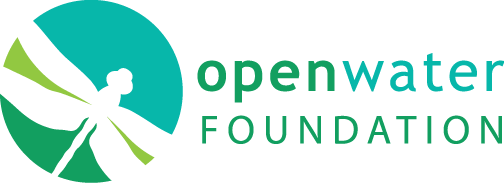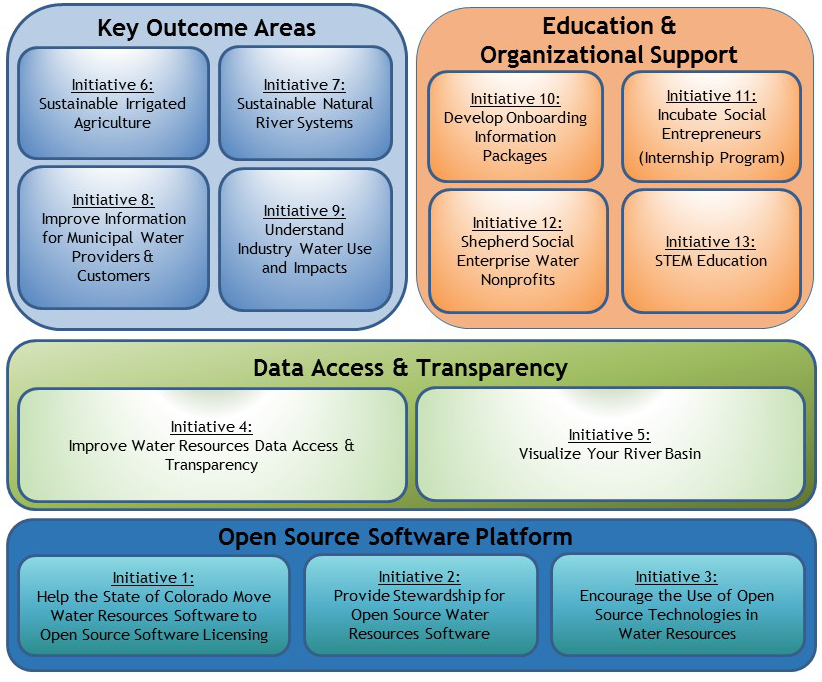Open Water Foundation (OWF) initiatives are the high-level focus areas for the work we do. Common threads are water, open source software, improved data access, transparency, and education. Projects may demonstrate a nexus across multiple initiatives. OWF seeks funding partners whose mission is connected to these initiatives. Initiatives in the following figure are grouped to illustrate OWF program areas, with foundational initiatives at the bottom.
Initiative 1 — Open Source Software Platform — Help the State of Colorado Move Water Resources Software to Open Source Software Licensing
The State of Colorado has invested in software tools for many years to help understand complex water resource issues in Colorado (see Colorado’s Decision Support Systems (CDSS)). However, budget cycles, limited human resources, and the State not being a software solutions business resulted in a sustainability gap for software tools. OWF helped the State move important software tools to open source licensing and projects. OWF continues to provide software support and and enhancements. See the OpenCDSS website for more information.
Initiative 2 — Open Source Software Platform — Provide Stewardship for Open Source Water Resources Software
Many organizations invest in software to study and manage water resources, ranging from complex Excel workbooks to custom software tools written in various languages. Often these tools are developed by individuals for a specific purpose and there is no plan for maintenance. In other cases, a useful tool may have been maintained for some time within an organization but the organization is no longer able to continue supporting the tool. OWF provides services to maintain, enhance, and integrate such tools with other technologies. OWF will work with organizations to move tools to open source licensing to ensure accessibility, can move software to modern technologies, and will implement development operations including version control and automated testing. An example of this work is OpenCDSS for the State of Colorado. OpenCDSS includes the TSTool software, which includes features funded by the US Bureau of Reclamation and Tennessee Valley Authority.
Initiative 3 — Open Source Software Platform — Encourage the Use of Open Source Software Technologies in Water Resources
Analyzing water resources issues is complex and requires the use of extensive data and powerful software tools, including geographic information systems (GIS), models, and visualization tools. The financial investment needed to purchase software and the time commitment to learn how to use software can be prohibitive for many organizations, in particular for small government agencies, nonprofits, and businesses. OWF leverages “best in class” open source software and develops new software solutions that provide useful functionality. For example, OWF has developed the GeoProcessor software to automate spatial data processing and the InfoMapper software to create informational websites. The resulting software increases access to information and decreases cost, which allows more organizations to analyze water resources problems, leading to a more nimble and educated community of problem-solvers. Open source software does have development and implement costs; however, the approach often leads to more collaborative, sustainable, and transparent technology solutions. See the OWF main website for access to software and learning resources on many open source tools.
Initiative 4 — Data Access & Transparency — Improve Water Resources Data Access and Transparency
Water resources data can be difficult to access and understand. Federal, state, and local organizations provide varying levels of data access in a variety of formats. Data users are often expected to understand data details based on limited explanation from data providers. OWF synthesizes data from multiple sources and provides context so that data users can understand and apply data for their questions. See the data.openwaterfoundation.org website for examples of datasets, which are often used to create data visualizations as described below.
Initiative 5 — Data Access & Transparency — Visualize Your River Basin
Understanding natural and human-impacted aspects of river systems is the key to understanding challenges and opportunities for those systems. For example, the Cache la Poudre River (the Poudre) in Northern Colorado is unique in its transition from high mountains to agricultural plains, with many water resource challenges. The basin’s history as a working river in addition to a portion being the only Wild and Scenic river in Colorado illustrates the complex challenges for the river. OWF has developed solutions to implement cross-jurisdictional community information resources for river basins, including the Poudre Basin Information (open in new tab) website. We continue to enhance software solutions in order to efficiently and effectively provide information that can be used for education, discussion, and decision-making for any river basin.
Initiative 6 — Key Outcome Area — Sustainable Irrigated Agriculture
Irrigated agriculture has had a profound impact on river systems in the arid west. Agricultural reservoirs dot the landscape and the peak flows of rivers have been smoothed out to ensure water supply for agriculture throughout the growing season. Agriculture uses over 80% of water supplies and in addition to food and other commodities provides wetlands and open space, replenishes groundwater, and provides economic benefits to communities. Dry-up of irrigated agriculture is often the first source of supply for growing cities as land developers acquire water supplies. OWF seeks to provide innovative data products and analysis tools to inform the discussion around irrigated agriculture – how can we preserve the values of agriculture while serving other needs? See for example a visualization of decreasing agricultural lands in Colorado (open in new tab) as water rights are reallocated to municipal use.
Initiative 7 — Key Outcome Area — Sustainable Natural River Systems
There is no doubt that one of the attractions of Colorado and other areas in the western USA is the beauty and bounty of natural river systems. Natural ecosystems provide recreational opportunities and a diverse ecosystem. However, due to pressures of increasing population, climate change, natural disasters, and other issues, environment is often the first victim of water shortages. OWF implements tools to monitor, analyze, and visualize data for natural river systems. Tools can provide a system-wide representation of river systems at spatial and temporal scale necessary to monitor and enhance environmental values, and support the activities of organizations interested in conserving and enhancing natural river systems. For example, OWF is working with partners to provide flow information for wildfire burn areas (open in new tab).
Initiative 8 — Key Outcome Area — Improve Information for Municipal Water Providers and Customers
Municipalities typically use less than 20% of the water when compared to agriculture. However, municipal utilities and water districts are experiencing increasing demand as population increases and supplies are impacted by climate change, drought, and long-term decrease in supplies. Consequently, water providers are seeking new supplies from agriculture, groundwater, and other sources. At the same time that water providers ask their customers to conserve water, they also ask for rate increases because much of the service cost is for fixed capital costs and commodities that are rising in price. These complexities and other issues require transparent access to information so that water providers can make good decisions and the public understands why decisions are made. OWF provides software tools to help municipal water providers and their customers gain a better understanding of water use and impacts using improved data analysis, visualization, and open data. See the Colorado Water Providers (open in new tab) map that is part of the Poudre Basin Information website for an example information product.
Initiative 9 — Key Outcome Area — Understand Industry Water Use and Impacts
Industry as an economic driver is directly impacted by water issues such as drought, disasters, cost, quality, and regulations. Industries such as energy development and manufacturing often pay a premium for water and are active in understanding impacts of water issues on operations. Industry also has an important role in sustainable practices and can lead by example. OWF is interested in helping industries understand their water use and impacts resulting from such use, in order to help ensure wise use of water resources while encouraging economic benefits to society. We also want to help provide transparency through open data standards and reporting so that industry can interface with government and public.
Initiative 10 — Education & Organizational Support — Developing Onboarding Information Packages
Many water organizations are challenged in that the complexity of water issues makes it difficult for new board members, city council, staff, and the public to understand an organization’s relationship with its own water resources and those of other entities in the the region. OWF implements information websites that educates organizations and the public about water issues, for example the Poudre Basin Information (open in new tab) website. Examples of organizations that can benefit include municipalities, ditch companies, water boards, utilities, conservation organizations, etc. Information resources also benefit water education programs such as Water Literate Leaders of Northern Colorado.
Initiative 11 — Education & Organizational Support — Incubating Social Entrepreneurs
The previous initiatives emphasize the unique mission and capabilities of OWF, which focuses on technologies, data, and analysis. However, technologies have little meaning without application to important social issues. Additionally, OWF recognizes the great challenges and opportunities for today’s youth, who are searching for purpose and impact. Consequently, OWF actively seeks out opportunities to engage students at every level to develop and apply data and analysis tools so that students can understand important water issues and make progress towards their solutions. We want to incubate social entrepreneurs who will have great impact in solving problems in water resources and areas that touch water. OWF has supported multiple interns to help students gain professional experience and insight into water resource problems.
Initiative 12 — Education & Organizational Support — Shepherd Social Enterprise Water Nonprofits
There is a role for nonprofit social enterprises in addressing important water issues. Social enterprises apply commercial strategies to maximize human and environmental well-being. OWF’s social enterprise start-up experience has pointed out opportunities to help other nonprofit organizations that are in the early stages of start-up or need support as they scale. We feel an obligation to help these organizations gain footing so that they can focus on their missions and have positive impact. OWF welcomes opportunities to help other nonprofits.
Initiative 13 — Education & Organizational Support — STEM Education
Science, Technology, Engineering, and Math (STEM) education is receiving extensive attention and investment to address the need for a qualified technical workforce in the United States. OWF recognizes the need to encourage STEM education and in particular the need for STEM professionals that understand the complexities of water resources, which often requires multi-faceted teams to solve complex programs. OWF supports STEM by making it easier for educators and students to use data, information, and software tools in their programs, which develops students as critical thinkers able to understand system interactions and processes. We also recognize the need to encourage and support girls to pursue STEM opportunities in their higher education and careers. OWF has supported STEM education by presenting our work to teachers and students. We also work with students on projects. See also the LEGO Hydrologic Model, which has been shown at conferences and water fairs.

